Entrepreneurship Report: Reflection on PAR's Business Model Canvas
VerifiedAdded on 2023/01/06
|7
|2372
|77
Report
AI Summary
This report reflects on a group presentation centered around the development of a business model canvas for a startup company, PAR, which focuses on selling eco-friendly cleaning products. The report details the entrepreneurial process, including the identification of a market need, the formulation of a business idea, and the creation of a business model canvas. The reflection highlights the collaborative efforts of the group, including the division of tasks, the application of relevant theories like Belbin's and Tuckman's theories, and the challenges faced, such as communication issues and time management. The report also analyzes the importance of customer relationships, the challenges of entrepreneurship, and the skills gained throughout the project. Furthermore, it emphasizes the importance of teamwork, and the application of theoretical frameworks to streamline the group activities. The conclusion summarizes the key takeaways and the value of reflective writing in understanding the learning experience.
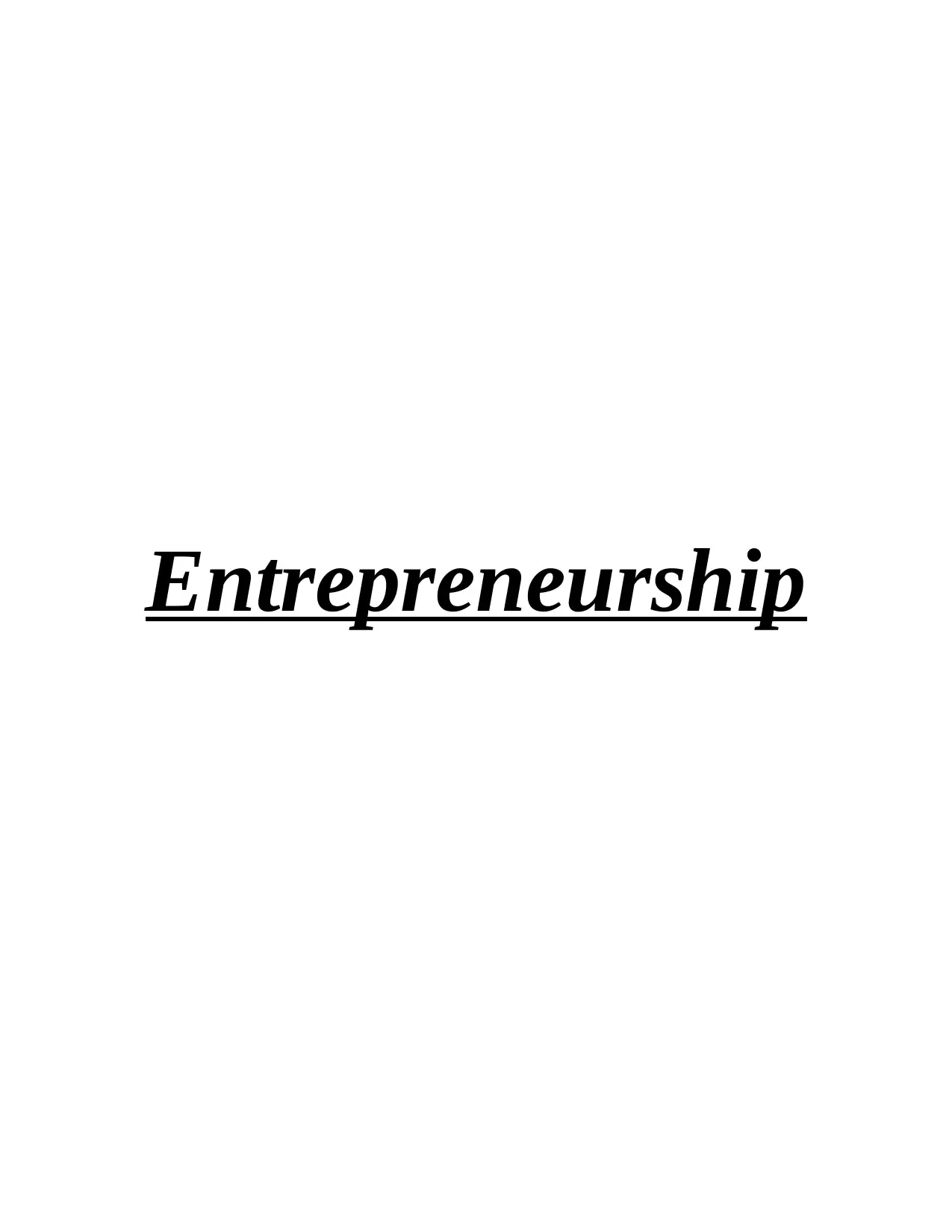
Entrepreneurship
Paraphrase This Document
Need a fresh take? Get an instant paraphrase of this document with our AI Paraphraser
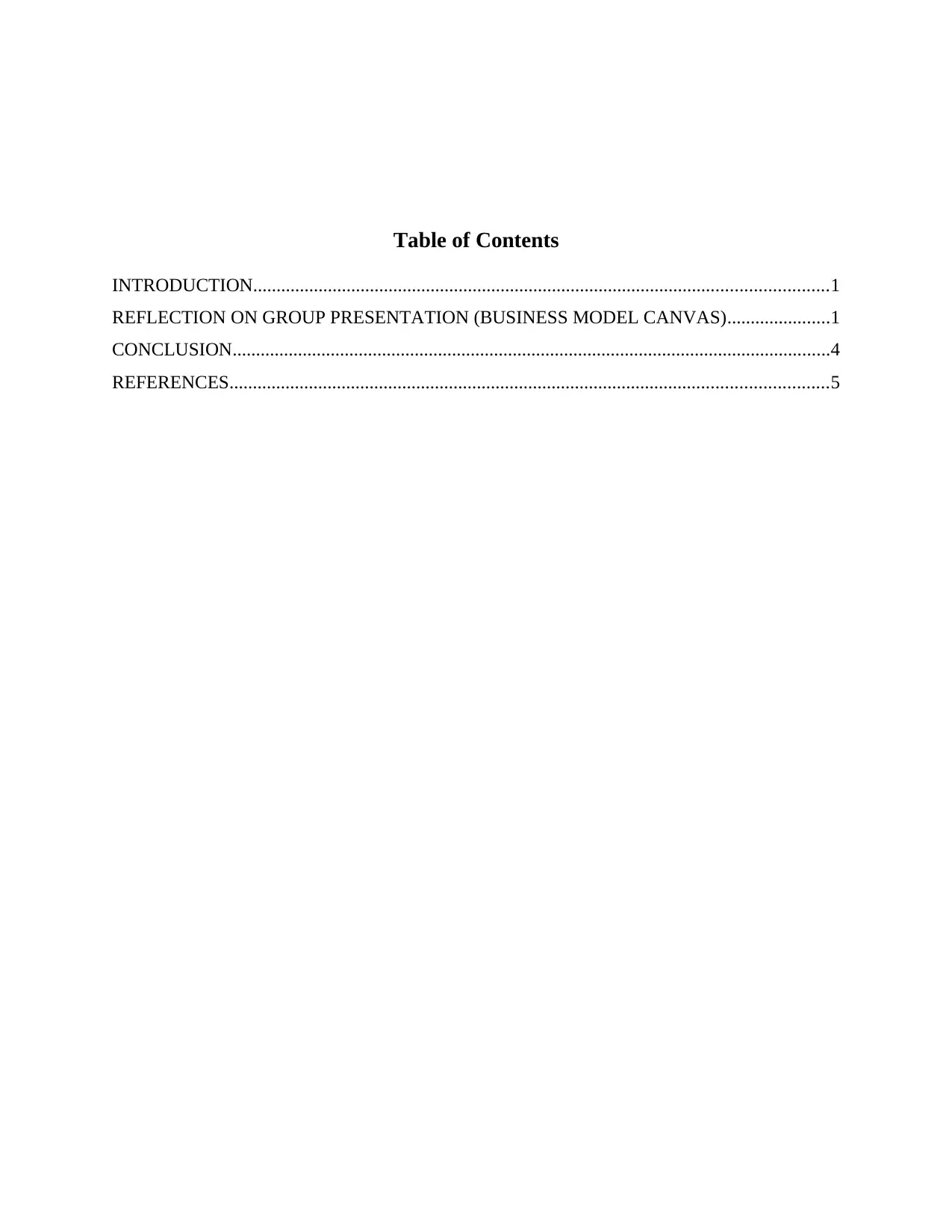
Table of Contents
INTRODUCTION...........................................................................................................................1
REFLECTION ON GROUP PRESENTATION (BUSINESS MODEL CANVAS)......................1
CONCLUSION................................................................................................................................4
REFERENCES................................................................................................................................5
INTRODUCTION...........................................................................................................................1
REFLECTION ON GROUP PRESENTATION (BUSINESS MODEL CANVAS)......................1
CONCLUSION................................................................................................................................4
REFERENCES................................................................................................................................5
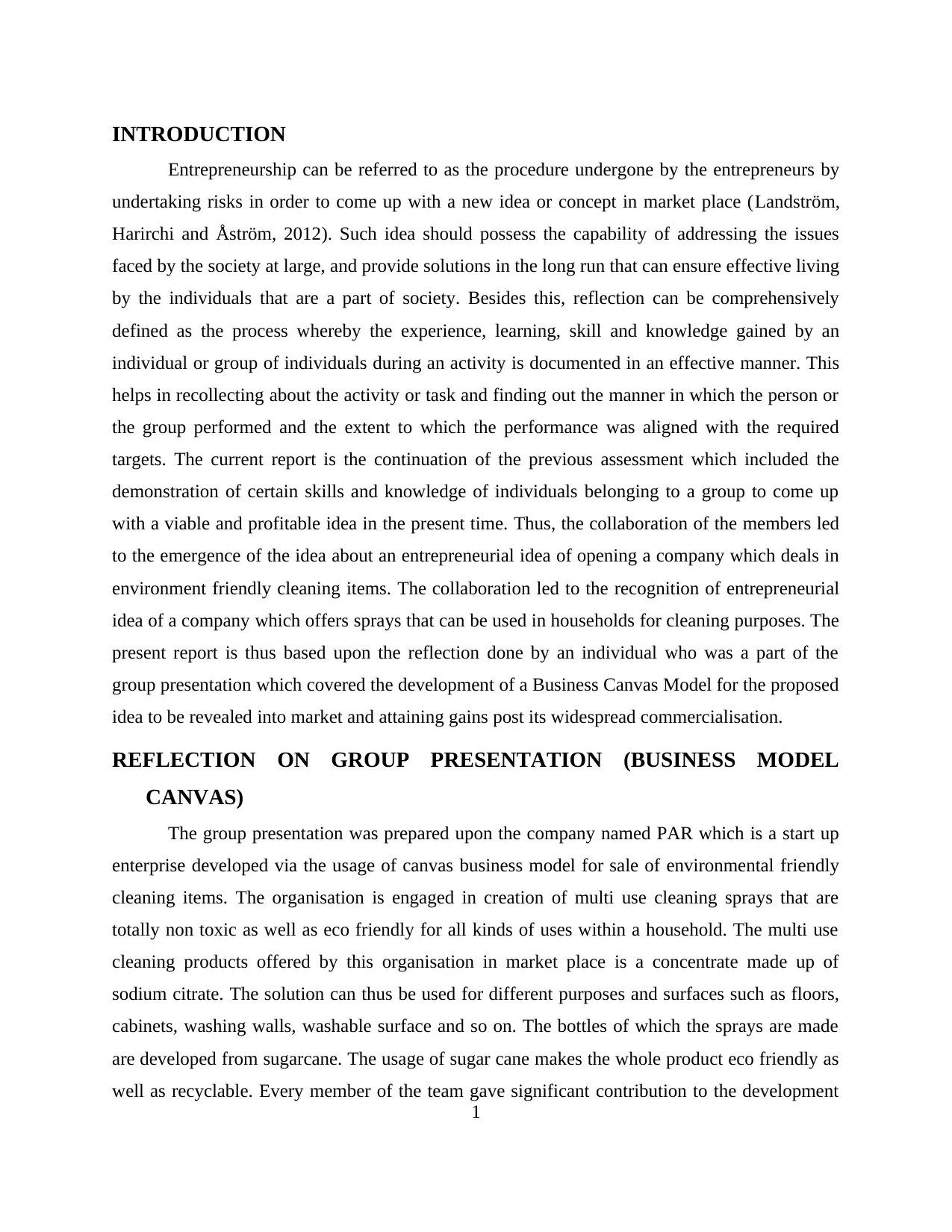
INTRODUCTION
Entrepreneurship can be referred to as the procedure undergone by the entrepreneurs by
undertaking risks in order to come up with a new idea or concept in market place (Landström,
Harirchi and Åström, 2012). Such idea should possess the capability of addressing the issues
faced by the society at large, and provide solutions in the long run that can ensure effective living
by the individuals that are a part of society. Besides this, reflection can be comprehensively
defined as the process whereby the experience, learning, skill and knowledge gained by an
individual or group of individuals during an activity is documented in an effective manner. This
helps in recollecting about the activity or task and finding out the manner in which the person or
the group performed and the extent to which the performance was aligned with the required
targets. The current report is the continuation of the previous assessment which included the
demonstration of certain skills and knowledge of individuals belonging to a group to come up
with a viable and profitable idea in the present time. Thus, the collaboration of the members led
to the emergence of the idea about an entrepreneurial idea of opening a company which deals in
environment friendly cleaning items. The collaboration led to the recognition of entrepreneurial
idea of a company which offers sprays that can be used in households for cleaning purposes. The
present report is thus based upon the reflection done by an individual who was a part of the
group presentation which covered the development of a Business Canvas Model for the proposed
idea to be revealed into market and attaining gains post its widespread commercialisation.
REFLECTION ON GROUP PRESENTATION (BUSINESS MODEL
CANVAS)
The group presentation was prepared upon the company named PAR which is a start up
enterprise developed via the usage of canvas business model for sale of environmental friendly
cleaning items. The organisation is engaged in creation of multi use cleaning sprays that are
totally non toxic as well as eco friendly for all kinds of uses within a household. The multi use
cleaning products offered by this organisation in market place is a concentrate made up of
sodium citrate. The solution can thus be used for different purposes and surfaces such as floors,
cabinets, washing walls, washable surface and so on. The bottles of which the sprays are made
are developed from sugarcane. The usage of sugar cane makes the whole product eco friendly as
well as recyclable. Every member of the team gave significant contribution to the development
1
Entrepreneurship can be referred to as the procedure undergone by the entrepreneurs by
undertaking risks in order to come up with a new idea or concept in market place (Landström,
Harirchi and Åström, 2012). Such idea should possess the capability of addressing the issues
faced by the society at large, and provide solutions in the long run that can ensure effective living
by the individuals that are a part of society. Besides this, reflection can be comprehensively
defined as the process whereby the experience, learning, skill and knowledge gained by an
individual or group of individuals during an activity is documented in an effective manner. This
helps in recollecting about the activity or task and finding out the manner in which the person or
the group performed and the extent to which the performance was aligned with the required
targets. The current report is the continuation of the previous assessment which included the
demonstration of certain skills and knowledge of individuals belonging to a group to come up
with a viable and profitable idea in the present time. Thus, the collaboration of the members led
to the emergence of the idea about an entrepreneurial idea of opening a company which deals in
environment friendly cleaning items. The collaboration led to the recognition of entrepreneurial
idea of a company which offers sprays that can be used in households for cleaning purposes. The
present report is thus based upon the reflection done by an individual who was a part of the
group presentation which covered the development of a Business Canvas Model for the proposed
idea to be revealed into market and attaining gains post its widespread commercialisation.
REFLECTION ON GROUP PRESENTATION (BUSINESS MODEL
CANVAS)
The group presentation was prepared upon the company named PAR which is a start up
enterprise developed via the usage of canvas business model for sale of environmental friendly
cleaning items. The organisation is engaged in creation of multi use cleaning sprays that are
totally non toxic as well as eco friendly for all kinds of uses within a household. The multi use
cleaning products offered by this organisation in market place is a concentrate made up of
sodium citrate. The solution can thus be used for different purposes and surfaces such as floors,
cabinets, washing walls, washable surface and so on. The bottles of which the sprays are made
are developed from sugarcane. The usage of sugar cane makes the whole product eco friendly as
well as recyclable. Every member of the team gave significant contribution to the development
1
⊘ This is a preview!⊘
Do you want full access?
Subscribe today to unlock all pages.

Trusted by 1+ million students worldwide
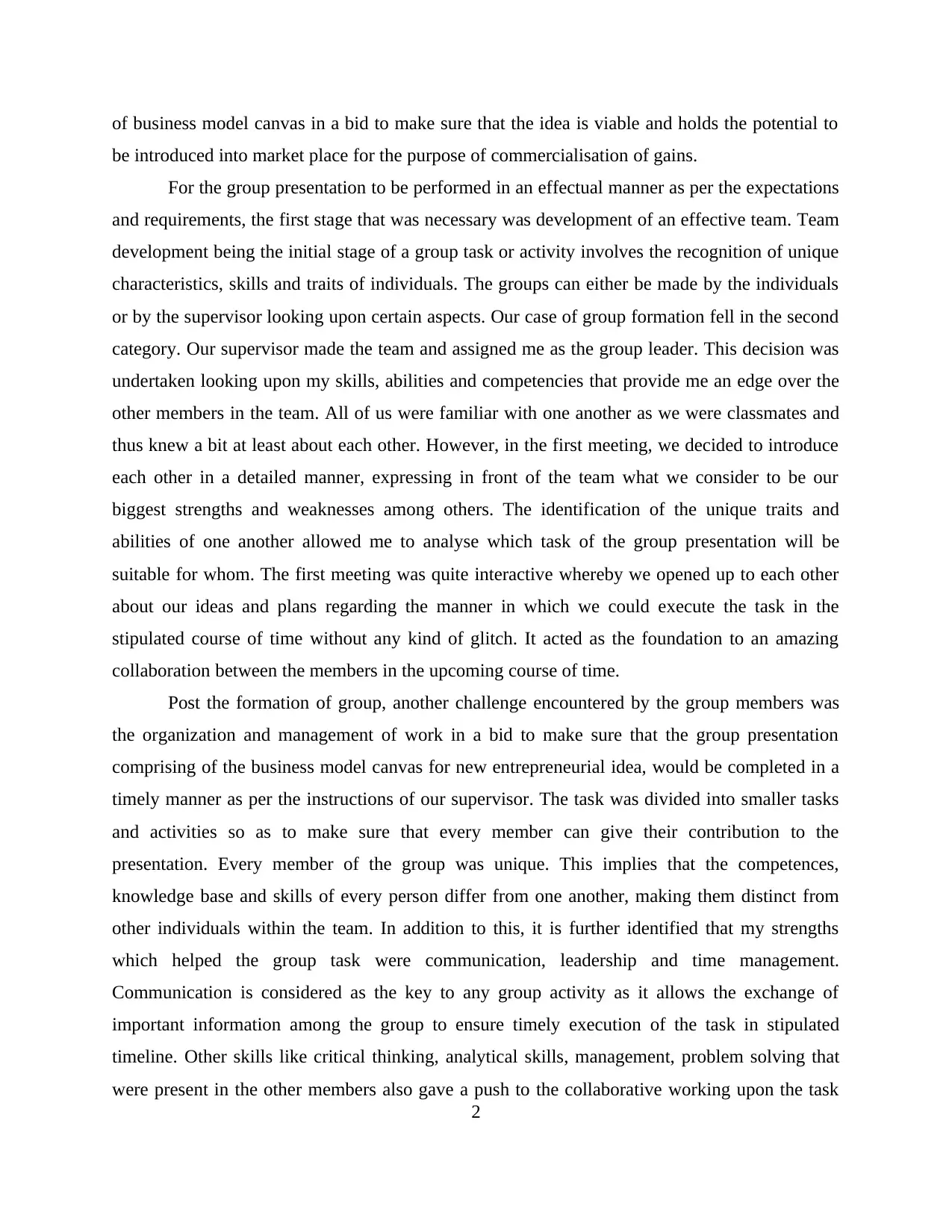
of business model canvas in a bid to make sure that the idea is viable and holds the potential to
be introduced into market place for the purpose of commercialisation of gains.
For the group presentation to be performed in an effectual manner as per the expectations
and requirements, the first stage that was necessary was development of an effective team. Team
development being the initial stage of a group task or activity involves the recognition of unique
characteristics, skills and traits of individuals. The groups can either be made by the individuals
or by the supervisor looking upon certain aspects. Our case of group formation fell in the second
category. Our supervisor made the team and assigned me as the group leader. This decision was
undertaken looking upon my skills, abilities and competencies that provide me an edge over the
other members in the team. All of us were familiar with one another as we were classmates and
thus knew a bit at least about each other. However, in the first meeting, we decided to introduce
each other in a detailed manner, expressing in front of the team what we consider to be our
biggest strengths and weaknesses among others. The identification of the unique traits and
abilities of one another allowed me to analyse which task of the group presentation will be
suitable for whom. The first meeting was quite interactive whereby we opened up to each other
about our ideas and plans regarding the manner in which we could execute the task in the
stipulated course of time without any kind of glitch. It acted as the foundation to an amazing
collaboration between the members in the upcoming course of time.
Post the formation of group, another challenge encountered by the group members was
the organization and management of work in a bid to make sure that the group presentation
comprising of the business model canvas for new entrepreneurial idea, would be completed in a
timely manner as per the instructions of our supervisor. The task was divided into smaller tasks
and activities so as to make sure that every member can give their contribution to the
presentation. Every member of the group was unique. This implies that the competences,
knowledge base and skills of every person differ from one another, making them distinct from
other individuals within the team. In addition to this, it is further identified that my strengths
which helped the group task were communication, leadership and time management.
Communication is considered as the key to any group activity as it allows the exchange of
important information among the group to ensure timely execution of the task in stipulated
timeline. Other skills like critical thinking, analytical skills, management, problem solving that
were present in the other members also gave a push to the collaborative working upon the task
2
be introduced into market place for the purpose of commercialisation of gains.
For the group presentation to be performed in an effectual manner as per the expectations
and requirements, the first stage that was necessary was development of an effective team. Team
development being the initial stage of a group task or activity involves the recognition of unique
characteristics, skills and traits of individuals. The groups can either be made by the individuals
or by the supervisor looking upon certain aspects. Our case of group formation fell in the second
category. Our supervisor made the team and assigned me as the group leader. This decision was
undertaken looking upon my skills, abilities and competencies that provide me an edge over the
other members in the team. All of us were familiar with one another as we were classmates and
thus knew a bit at least about each other. However, in the first meeting, we decided to introduce
each other in a detailed manner, expressing in front of the team what we consider to be our
biggest strengths and weaknesses among others. The identification of the unique traits and
abilities of one another allowed me to analyse which task of the group presentation will be
suitable for whom. The first meeting was quite interactive whereby we opened up to each other
about our ideas and plans regarding the manner in which we could execute the task in the
stipulated course of time without any kind of glitch. It acted as the foundation to an amazing
collaboration between the members in the upcoming course of time.
Post the formation of group, another challenge encountered by the group members was
the organization and management of work in a bid to make sure that the group presentation
comprising of the business model canvas for new entrepreneurial idea, would be completed in a
timely manner as per the instructions of our supervisor. The task was divided into smaller tasks
and activities so as to make sure that every member can give their contribution to the
presentation. Every member of the group was unique. This implies that the competences,
knowledge base and skills of every person differ from one another, making them distinct from
other individuals within the team. In addition to this, it is further identified that my strengths
which helped the group task were communication, leadership and time management.
Communication is considered as the key to any group activity as it allows the exchange of
important information among the group to ensure timely execution of the task in stipulated
timeline. Other skills like critical thinking, analytical skills, management, problem solving that
were present in the other members also gave a push to the collaborative working upon the task
2
Paraphrase This Document
Need a fresh take? Get an instant paraphrase of this document with our AI Paraphraser
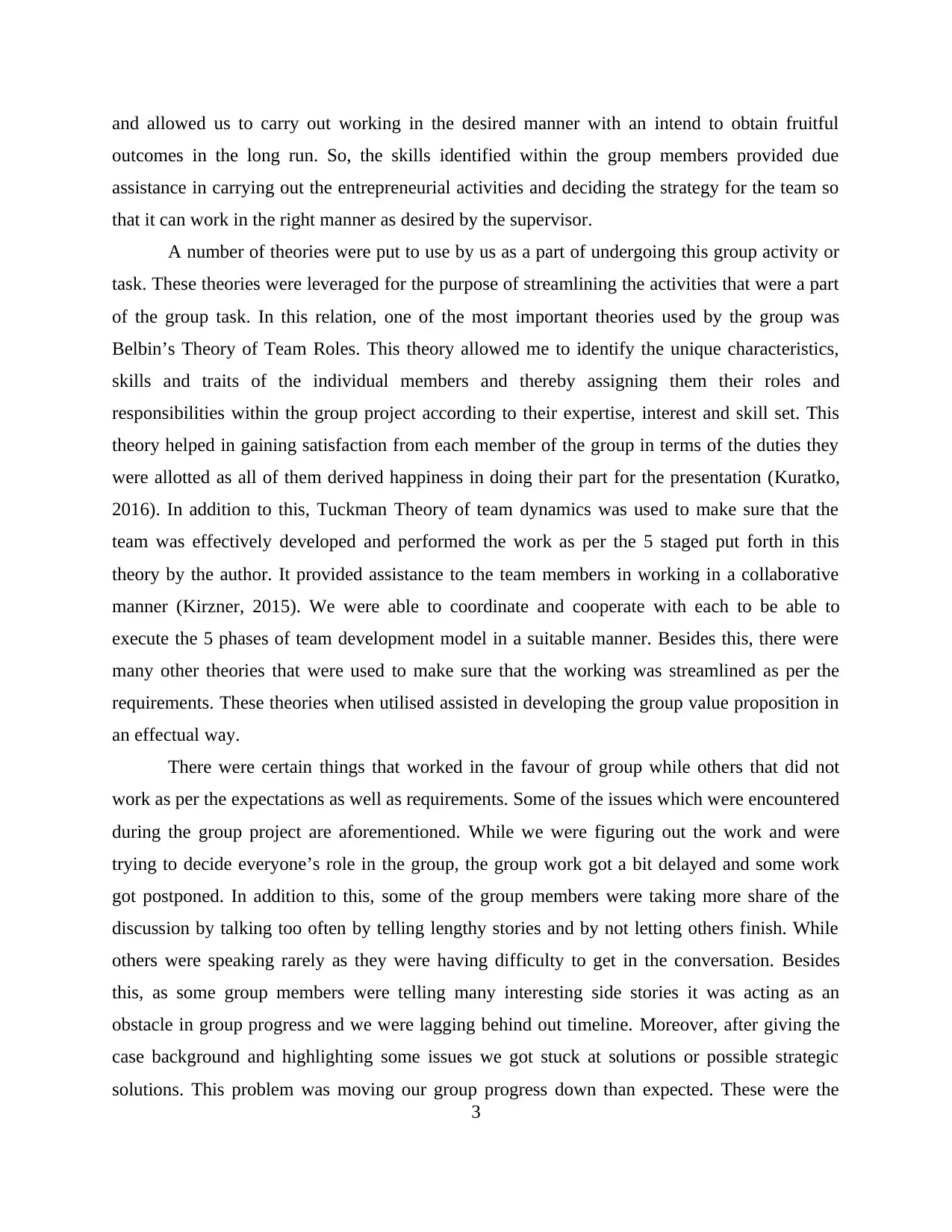
and allowed us to carry out working in the desired manner with an intend to obtain fruitful
outcomes in the long run. So, the skills identified within the group members provided due
assistance in carrying out the entrepreneurial activities and deciding the strategy for the team so
that it can work in the right manner as desired by the supervisor.
A number of theories were put to use by us as a part of undergoing this group activity or
task. These theories were leveraged for the purpose of streamlining the activities that were a part
of the group task. In this relation, one of the most important theories used by the group was
Belbin’s Theory of Team Roles. This theory allowed me to identify the unique characteristics,
skills and traits of the individual members and thereby assigning them their roles and
responsibilities within the group project according to their expertise, interest and skill set. This
theory helped in gaining satisfaction from each member of the group in terms of the duties they
were allotted as all of them derived happiness in doing their part for the presentation (Kuratko,
2016). In addition to this, Tuckman Theory of team dynamics was used to make sure that the
team was effectively developed and performed the work as per the 5 staged put forth in this
theory by the author. It provided assistance to the team members in working in a collaborative
manner (Kirzner, 2015). We were able to coordinate and cooperate with each to be able to
execute the 5 phases of team development model in a suitable manner. Besides this, there were
many other theories that were used to make sure that the working was streamlined as per the
requirements. These theories when utilised assisted in developing the group value proposition in
an effectual way.
There were certain things that worked in the favour of group while others that did not
work as per the expectations as well as requirements. Some of the issues which were encountered
during the group project are aforementioned. While we were figuring out the work and were
trying to decide everyone’s role in the group, the group work got a bit delayed and some work
got postponed. In addition to this, some of the group members were taking more share of the
discussion by talking too often by telling lengthy stories and by not letting others finish. While
others were speaking rarely as they were having difficulty to get in the conversation. Besides
this, as some group members were telling many interesting side stories it was acting as an
obstacle in group progress and we were lagging behind out timeline. Moreover, after giving the
case background and highlighting some issues we got stuck at solutions or possible strategic
solutions. This problem was moving our group progress down than expected. These were the
3
outcomes in the long run. So, the skills identified within the group members provided due
assistance in carrying out the entrepreneurial activities and deciding the strategy for the team so
that it can work in the right manner as desired by the supervisor.
A number of theories were put to use by us as a part of undergoing this group activity or
task. These theories were leveraged for the purpose of streamlining the activities that were a part
of the group task. In this relation, one of the most important theories used by the group was
Belbin’s Theory of Team Roles. This theory allowed me to identify the unique characteristics,
skills and traits of the individual members and thereby assigning them their roles and
responsibilities within the group project according to their expertise, interest and skill set. This
theory helped in gaining satisfaction from each member of the group in terms of the duties they
were allotted as all of them derived happiness in doing their part for the presentation (Kuratko,
2016). In addition to this, Tuckman Theory of team dynamics was used to make sure that the
team was effectively developed and performed the work as per the 5 staged put forth in this
theory by the author. It provided assistance to the team members in working in a collaborative
manner (Kirzner, 2015). We were able to coordinate and cooperate with each to be able to
execute the 5 phases of team development model in a suitable manner. Besides this, there were
many other theories that were used to make sure that the working was streamlined as per the
requirements. These theories when utilised assisted in developing the group value proposition in
an effectual way.
There were certain things that worked in the favour of group while others that did not
work as per the expectations as well as requirements. Some of the issues which were encountered
during the group project are aforementioned. While we were figuring out the work and were
trying to decide everyone’s role in the group, the group work got a bit delayed and some work
got postponed. In addition to this, some of the group members were taking more share of the
discussion by talking too often by telling lengthy stories and by not letting others finish. While
others were speaking rarely as they were having difficulty to get in the conversation. Besides
this, as some group members were telling many interesting side stories it was acting as an
obstacle in group progress and we were lagging behind out timeline. Moreover, after giving the
case background and highlighting some issues we got stuck at solutions or possible strategic
solutions. This problem was moving our group progress down than expected. These were the
3
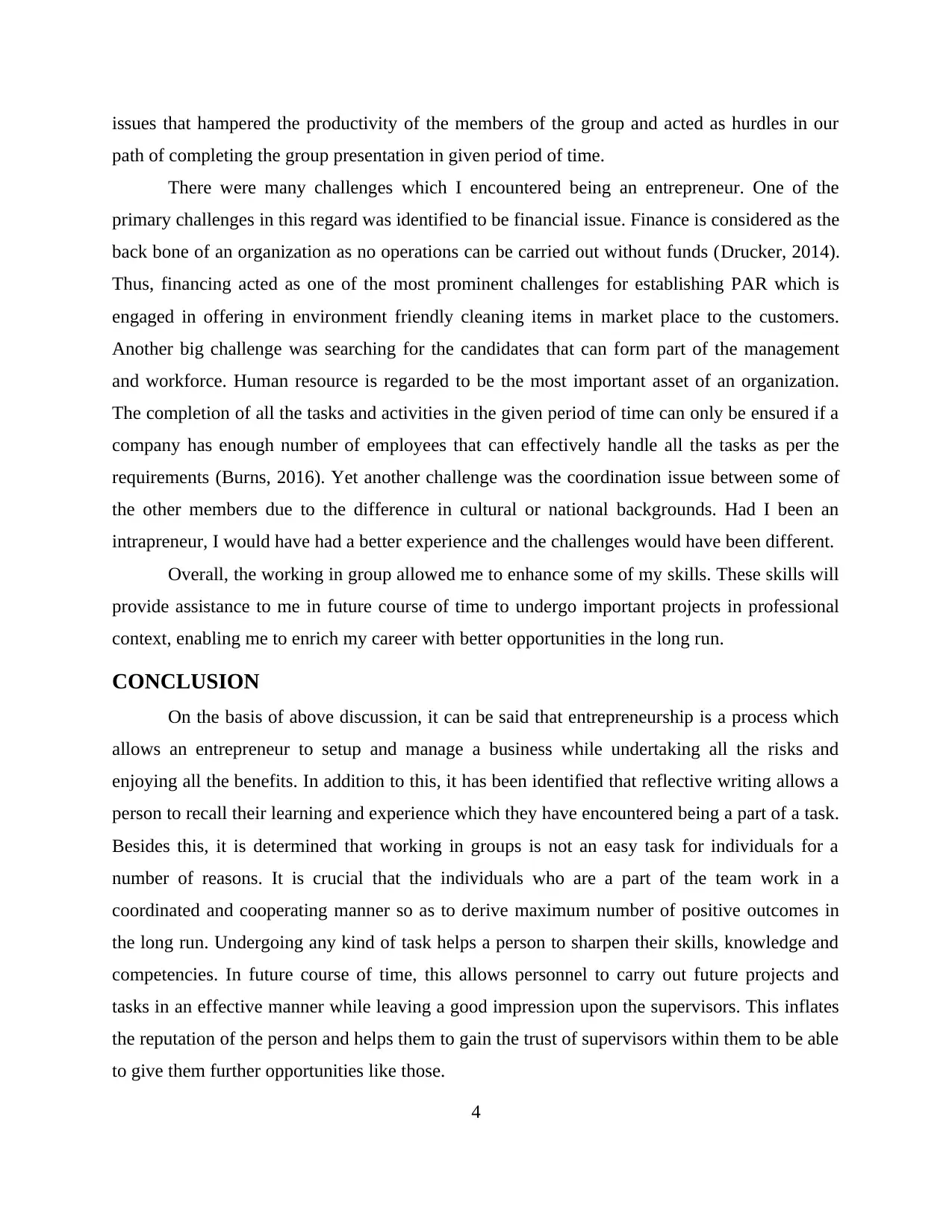
issues that hampered the productivity of the members of the group and acted as hurdles in our
path of completing the group presentation in given period of time.
There were many challenges which I encountered being an entrepreneur. One of the
primary challenges in this regard was identified to be financial issue. Finance is considered as the
back bone of an organization as no operations can be carried out without funds (Drucker, 2014).
Thus, financing acted as one of the most prominent challenges for establishing PAR which is
engaged in offering in environment friendly cleaning items in market place to the customers.
Another big challenge was searching for the candidates that can form part of the management
and workforce. Human resource is regarded to be the most important asset of an organization.
The completion of all the tasks and activities in the given period of time can only be ensured if a
company has enough number of employees that can effectively handle all the tasks as per the
requirements (Burns, 2016). Yet another challenge was the coordination issue between some of
the other members due to the difference in cultural or national backgrounds. Had I been an
intrapreneur, I would have had a better experience and the challenges would have been different.
Overall, the working in group allowed me to enhance some of my skills. These skills will
provide assistance to me in future course of time to undergo important projects in professional
context, enabling me to enrich my career with better opportunities in the long run.
CONCLUSION
On the basis of above discussion, it can be said that entrepreneurship is a process which
allows an entrepreneur to setup and manage a business while undertaking all the risks and
enjoying all the benefits. In addition to this, it has been identified that reflective writing allows a
person to recall their learning and experience which they have encountered being a part of a task.
Besides this, it is determined that working in groups is not an easy task for individuals for a
number of reasons. It is crucial that the individuals who are a part of the team work in a
coordinated and cooperating manner so as to derive maximum number of positive outcomes in
the long run. Undergoing any kind of task helps a person to sharpen their skills, knowledge and
competencies. In future course of time, this allows personnel to carry out future projects and
tasks in an effective manner while leaving a good impression upon the supervisors. This inflates
the reputation of the person and helps them to gain the trust of supervisors within them to be able
to give them further opportunities like those.
4
path of completing the group presentation in given period of time.
There were many challenges which I encountered being an entrepreneur. One of the
primary challenges in this regard was identified to be financial issue. Finance is considered as the
back bone of an organization as no operations can be carried out without funds (Drucker, 2014).
Thus, financing acted as one of the most prominent challenges for establishing PAR which is
engaged in offering in environment friendly cleaning items in market place to the customers.
Another big challenge was searching for the candidates that can form part of the management
and workforce. Human resource is regarded to be the most important asset of an organization.
The completion of all the tasks and activities in the given period of time can only be ensured if a
company has enough number of employees that can effectively handle all the tasks as per the
requirements (Burns, 2016). Yet another challenge was the coordination issue between some of
the other members due to the difference in cultural or national backgrounds. Had I been an
intrapreneur, I would have had a better experience and the challenges would have been different.
Overall, the working in group allowed me to enhance some of my skills. These skills will
provide assistance to me in future course of time to undergo important projects in professional
context, enabling me to enrich my career with better opportunities in the long run.
CONCLUSION
On the basis of above discussion, it can be said that entrepreneurship is a process which
allows an entrepreneur to setup and manage a business while undertaking all the risks and
enjoying all the benefits. In addition to this, it has been identified that reflective writing allows a
person to recall their learning and experience which they have encountered being a part of a task.
Besides this, it is determined that working in groups is not an easy task for individuals for a
number of reasons. It is crucial that the individuals who are a part of the team work in a
coordinated and cooperating manner so as to derive maximum number of positive outcomes in
the long run. Undergoing any kind of task helps a person to sharpen their skills, knowledge and
competencies. In future course of time, this allows personnel to carry out future projects and
tasks in an effective manner while leaving a good impression upon the supervisors. This inflates
the reputation of the person and helps them to gain the trust of supervisors within them to be able
to give them further opportunities like those.
4
⊘ This is a preview!⊘
Do you want full access?
Subscribe today to unlock all pages.

Trusted by 1+ million students worldwide
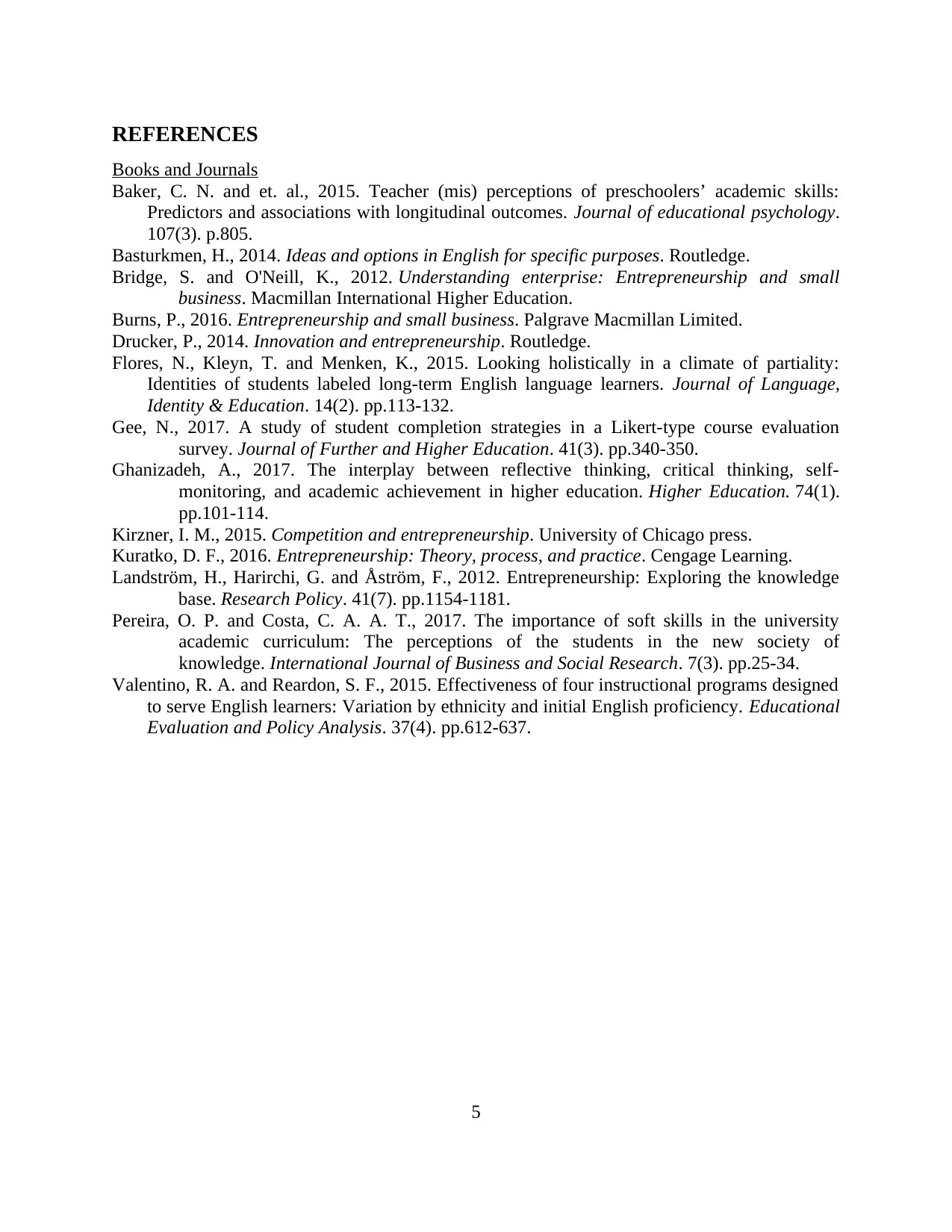
REFERENCES
Books and Journals
Baker, C. N. and et. al., 2015. Teacher (mis) perceptions of preschoolers’ academic skills:
Predictors and associations with longitudinal outcomes. Journal of educational psychology.
107(3). p.805.
Basturkmen, H., 2014. Ideas and options in English for specific purposes. Routledge.
Bridge, S. and O'Neill, K., 2012. Understanding enterprise: Entrepreneurship and small
business. Macmillan International Higher Education.
Burns, P., 2016. Entrepreneurship and small business. Palgrave Macmillan Limited.
Drucker, P., 2014. Innovation and entrepreneurship. Routledge.
Flores, N., Kleyn, T. and Menken, K., 2015. Looking holistically in a climate of partiality:
Identities of students labeled long-term English language learners. Journal of Language,
Identity & Education. 14(2). pp.113-132.
Gee, N., 2017. A study of student completion strategies in a Likert-type course evaluation
survey. Journal of Further and Higher Education. 41(3). pp.340-350.
Ghanizadeh, A., 2017. The interplay between reflective thinking, critical thinking, self-
monitoring, and academic achievement in higher education. Higher Education. 74(1).
pp.101-114.
Kirzner, I. M., 2015. Competition and entrepreneurship. University of Chicago press.
Kuratko, D. F., 2016. Entrepreneurship: Theory, process, and practice. Cengage Learning.
Landström, H., Harirchi, G. and Åström, F., 2012. Entrepreneurship: Exploring the knowledge
base. Research Policy. 41(7). pp.1154-1181.
Pereira, O. P. and Costa, C. A. A. T., 2017. The importance of soft skills in the university
academic curriculum: The perceptions of the students in the new society of
knowledge. International Journal of Business and Social Research. 7(3). pp.25-34.
Valentino, R. A. and Reardon, S. F., 2015. Effectiveness of four instructional programs designed
to serve English learners: Variation by ethnicity and initial English proficiency. Educational
Evaluation and Policy Analysis. 37(4). pp.612-637.
5
Books and Journals
Baker, C. N. and et. al., 2015. Teacher (mis) perceptions of preschoolers’ academic skills:
Predictors and associations with longitudinal outcomes. Journal of educational psychology.
107(3). p.805.
Basturkmen, H., 2014. Ideas and options in English for specific purposes. Routledge.
Bridge, S. and O'Neill, K., 2012. Understanding enterprise: Entrepreneurship and small
business. Macmillan International Higher Education.
Burns, P., 2016. Entrepreneurship and small business. Palgrave Macmillan Limited.
Drucker, P., 2014. Innovation and entrepreneurship. Routledge.
Flores, N., Kleyn, T. and Menken, K., 2015. Looking holistically in a climate of partiality:
Identities of students labeled long-term English language learners. Journal of Language,
Identity & Education. 14(2). pp.113-132.
Gee, N., 2017. A study of student completion strategies in a Likert-type course evaluation
survey. Journal of Further and Higher Education. 41(3). pp.340-350.
Ghanizadeh, A., 2017. The interplay between reflective thinking, critical thinking, self-
monitoring, and academic achievement in higher education. Higher Education. 74(1).
pp.101-114.
Kirzner, I. M., 2015. Competition and entrepreneurship. University of Chicago press.
Kuratko, D. F., 2016. Entrepreneurship: Theory, process, and practice. Cengage Learning.
Landström, H., Harirchi, G. and Åström, F., 2012. Entrepreneurship: Exploring the knowledge
base. Research Policy. 41(7). pp.1154-1181.
Pereira, O. P. and Costa, C. A. A. T., 2017. The importance of soft skills in the university
academic curriculum: The perceptions of the students in the new society of
knowledge. International Journal of Business and Social Research. 7(3). pp.25-34.
Valentino, R. A. and Reardon, S. F., 2015. Effectiveness of four instructional programs designed
to serve English learners: Variation by ethnicity and initial English proficiency. Educational
Evaluation and Policy Analysis. 37(4). pp.612-637.
5
1 out of 7
Related Documents
Your All-in-One AI-Powered Toolkit for Academic Success.
+13062052269
info@desklib.com
Available 24*7 on WhatsApp / Email
![[object Object]](/_next/static/media/star-bottom.7253800d.svg)
Unlock your academic potential
Copyright © 2020–2025 A2Z Services. All Rights Reserved. Developed and managed by ZUCOL.





